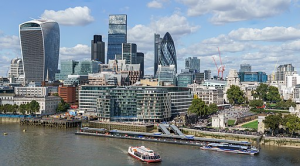 A new way of assessing sustainability takes into account a structure’s entire history and future, not just its energy bill, reports SLATE.
A new way of assessing sustainability takes into account a structure’s entire history and future, not just its energy bill, reports SLATE.
image: © User:Colin and Kim Hansen / Wikimedia Commons
https://upload.wikimedia.org/wikipedia/commons/6/6d/
City_of_London_skyline_from_London_City_Hall_-_
Sept_2015_-_Crop_Aligned.jpg
… Tulip’s ‘unsustainable whole life-cycle,’…
SLATE writes:
Even by the standards of London’s glassy skyscraper district, which includes buildings nicknamed for a walkie-talkie and a cornichon, the Tulip would have been a weird one. The design, by the British architect Norman Foster, featured a 50-foot-wide concrete shaft supporting a multilevel observation deck a thousand feet over London Bridge. There was no office space. No housing. Just a big pole with a view, which, in these times, looked less like a flower than a swab testing the London sky for COVID-19.
Last month, the U.K. government rejected the design….
….When planning inspector David Nicholson referred to the Tulip’s “unsustainable whole life-cycle,” he was making a broader assessment of the project’s environmental costs, from the demolition of the site’s existing structures to the concrete in the tower core….
Embodied carbon is an attempt, in other words, to more fully reckon with the impact of buildings on the planet….
Accounting for embodied carbon gives a shot in the arm to preservation and conservation movements….
….Reporters probe the unsavory roots of supposedly eco-friendly products like electric cars and the grim end of life of green infrastructure like windmills.
Asking the same of concrete, steel, and glass has been the project of Myrrh Caplan, the sustainability director at the construction and development firm Skanska USA. Two years ago, she helped develop the Embodied Carbon in Construction Calculator, or EC3, to assess the carbon impacts of construction, from materials to transportation to on-site energy use. Some of the improvements Caplan counsels can seem picayune, such as insulating on-site work trailers, reducing idling, encouraging construction workers to use transit, and swapping out containers for open-bed shipping….
So far, the only incentive to use a tool like EC3 and focus on embodied carbon is good PR—and the PR isn’t even that good, since few people know what “embodied carbon” is. Green building awards such as LEED are mostly focused on operational energy. With some rare exceptions, regulations remain tailored to reducing buildings’ energy bills, with incentives aligned in favor of newer structures, not older ones.
The hope, says Kim Cheslak, the director of codes at the sustainability-focused New Buildings Institute, is that awareness of embodied carbon will change the way people think about design and construction….

